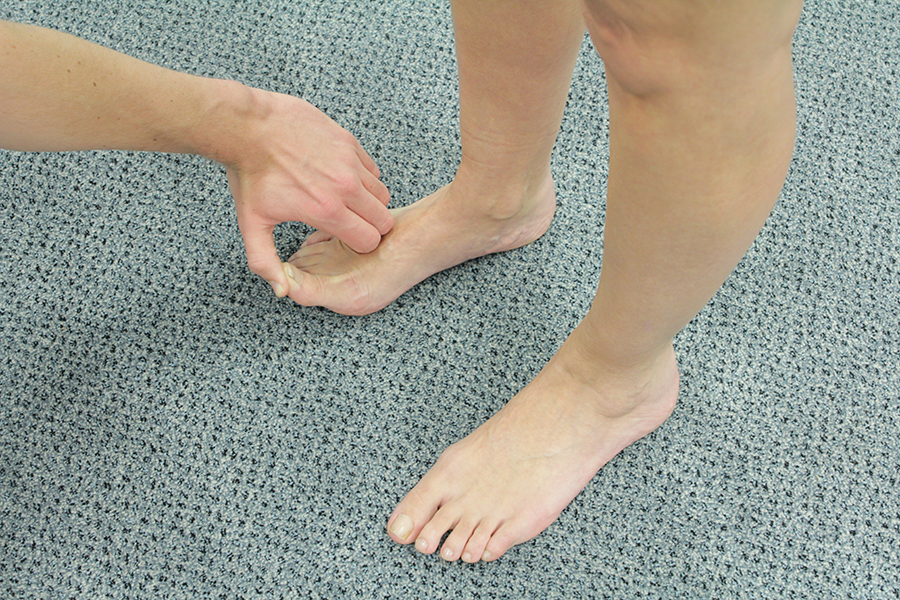Turf toe
Turf toe describes a sprain to the big toe caused by hyper-extension. Turf toe is most commonly seen in those who play sports.
Turf toe (otherwise known as a big toe sprain) is an injury that occurs at the big toe joint. Turf toe occurs when the big toe joint is forced past its range of motion, which produces pain as the ligaments (which hold the joint together) are over stretched.
Turf toe occurs when the big toe joint is hyper-extended, this means that the joint is forced past it full range of motion. Certain activities and sports can increase the risk of turf toe, these include:
The signs and symptoms of turf toe include:

Turf toe refers to a sprain of the big toe joint, as a result turf toe can be classified according to how severe the sprain is.
Type 1
Type one is mild and the most common form of turf toe. Type one sprained typically present with a small amount of localised swelling and bruising.
Type 2
Type 2 is moderate. A type 2 sprain has partial tears to the ligaments, but the cartilage remains undamaged. There is diffuse swelling and bruising, with limited movement at the joint.
Type 3
Type 3 is the most severe type of sprain. Type 3 sprains include torn ligaments and a torn joint capsule, which makes the big toe joint unstable. The patient will have difficulty placing weight on the joint, and there will be a limited amount of movement as well as a large amount of swelling and bruising.
Our podiatrists at Chiropody.co.uk will diagnose turf toe based on an assessment. The assessment includes a medical and social history, signs and symptoms and an examination.
If you have turf toe podiatry will benefit you. The pain that is felt as a result of turf toe is due to inflammation. The inflammation associated with turf toe has occurred as a result of over stretching and injury to the ligaments that hold the big toe joint together. Podiatry can help you if you have turf toe by stabilising the joint of the big toe, which will give the toe time to heal as well as prevent further injury.
At Chiropody.co.uk all initial appointments begin with an assessment, this includes taking down a thorough medical history, social history and history of injury. The initial assessment along with the signs and symptoms and an examination of the injured toe will lead the podiatrist to the correct diagnosis, so that an appropriate treatment plan can be put into place.
The treatment options that may be recommended if you have turf toe include:
 Summary
Summary
Turf toe (big toe sprain) is a hyper-extension injury of the big toe joint. The big toe joint is held together by ligaments which are strong fibrous bands, when these are over stretched a sprain occurs. A number of activities can make a person more prone to big toe sprain, particularly those that might force the big toe joint into hyper'extension. There are three categories of big toe sprain which indicate the severity of the injury; however the typical signs and symptoms include pain, swelling and bruising. At Chiropody.co.uk we will be able to advise you on the best treatment for you.
To arrange an assessment with one our podiatrists please email office@chiropody.co.uk or call 0330 088 4222.
What is turf toe?
Turf toe (otherwise known as a big toe sprain) is an injury that occurs at the big toe joint. Turf toe occurs when the big toe joint is forced past its range of motion, which produces pain as the ligaments (which hold the joint together) are over stretched.
What causes turf toe?
Turf toe occurs when the big toe joint is hyper-extended, this means that the joint is forced past it full range of motion. Certain activities and sports can increase the risk of turf toe, these include:
- Football
- Rugby
- Dance
- Basketball
- Running
What are the signs and symptoms of turf toe?
The signs and symptoms of turf toe include:
- Swelling of the toe joint
- Pain and tenderness particularly when walking and the propelling phase of gait
- Bruising

Types of turf toe?
Turf toe refers to a sprain of the big toe joint, as a result turf toe can be classified according to how severe the sprain is.
Type 1
Type one is mild and the most common form of turf toe. Type one sprained typically present with a small amount of localised swelling and bruising.
Type 2
Type 2 is moderate. A type 2 sprain has partial tears to the ligaments, but the cartilage remains undamaged. There is diffuse swelling and bruising, with limited movement at the joint.
Type 3
Type 3 is the most severe type of sprain. Type 3 sprains include torn ligaments and a torn joint capsule, which makes the big toe joint unstable. The patient will have difficulty placing weight on the joint, and there will be a limited amount of movement as well as a large amount of swelling and bruising.
How is big turf toe diagnosed?
Our podiatrists at Chiropody.co.uk will diagnose turf toe based on an assessment. The assessment includes a medical and social history, signs and symptoms and an examination.
Benefits of podiatry for turf toe
If you have turf toe podiatry will benefit you. The pain that is felt as a result of turf toe is due to inflammation. The inflammation associated with turf toe has occurred as a result of over stretching and injury to the ligaments that hold the big toe joint together. Podiatry can help you if you have turf toe by stabilising the joint of the big toe, which will give the toe time to heal as well as prevent further injury.
What would podiatry for turf toe involve?
At Chiropody.co.uk all initial appointments begin with an assessment, this includes taking down a thorough medical history, social history and history of injury. The initial assessment along with the signs and symptoms and an examination of the injured toe will lead the podiatrist to the correct diagnosis, so that an appropriate treatment plan can be put into place.
The treatment options that may be recommended if you have turf toe include:
- R.I.C.E: rest, ice, compression, elevation
- Anti-inflammatory advice
- Taping
- Orthoses
- Manual therapy
- Ultrasound
- Acupuncture
- Advice and education
- Footwear review
 Summary
Summary
Turf toe (big toe sprain) is a hyper-extension injury of the big toe joint. The big toe joint is held together by ligaments which are strong fibrous bands, when these are over stretched a sprain occurs. A number of activities can make a person more prone to big toe sprain, particularly those that might force the big toe joint into hyper'extension. There are three categories of big toe sprain which indicate the severity of the injury; however the typical signs and symptoms include pain, swelling and bruising. At Chiropody.co.uk we will be able to advise you on the best treatment for you.
To arrange an assessment with one our podiatrists please email office@chiropody.co.uk or call 0330 088 4222.
Save 5% by booking an appointment online.

Find your nearest clinic
We have clinics located throughout the North West. We also provide a home visit service.
Find out more »

No waiting lists!
Tired of waiting for treatment? Be seen by a podiatrist today!
Find out more »

Not sure how we can help?
Speak to a podiatrist to find out how we can help. Call us on 0330 088 4222.
Find out more »
We work with:

Individuals

Organisations

Health professionals
Get in Touch!
0330 088 4222
If you would like to speak to one of our specialists then please complete this form.
We are open 7 days a week








